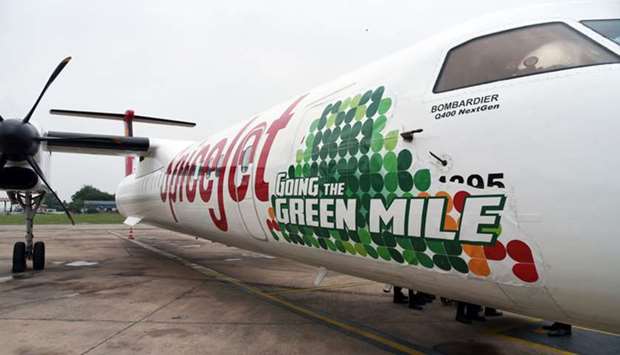Covid-19 lockdowns have led to an almost complete standstill in airline travel worldwide. Many airlines have grounded most of their flights, globally.
Obviously, grounded planes do not make money. In fact, storing and maintaining them comes at a hefty price tag!
Since the pandemic, airlines have been counting the cost of lost business, a debt pile swollen by bailouts and a diminished demand outlook.
A sharp fall in demand and revenue has forced many airlines to slash costs, and in several countries, governments have stepped in to infuse funds and keep their national airlines, or flagbearers, afloat.
Although it may take months, if not years, to fully recover from the impacts of Covid-19, industry captains are now working on ways to help power aviation’s contribution to the post-pandemic recovery.
Experts affirm post-Covid-19 “green recovery” must embrace Sustainable Aviation Fuels (SAF) in line with the aviation industry’s commitment to its emissions reduction goals.
Air transport accounts for 2% of global man-made CO2 emissions. In 2017, civil aviation, as a whole, emitted around 859mn tonnes of CO2, which is roughly 2% of man-made carbon emissions.
It is estimated that (under the industry’s trend setting initiative CORSIA or Carbon Offsetting and Reduction Scheme for International Aviation — a global carbon offsetting scheme) aviation will have to offset 2.6bn tonnes of CO2 between 2021 and 2035.
The world must “build back better” from the Covid-19 crisis with attention focused on investment in carbon reduction technologies and in SAF, which according to the International Air Transport Association, will create jobs at this critical time and boost aviation’s progress towards its goal to cut aviation emissions to half 2005 levels by 2050.
Current SAF production is 50mn litres annually, according to an IATA estimate.
To reach a tipping point, where the scale of production will see SAF costs drop to levels competitive with jet fuel, the production needs to reach 7bn litres or 2% of 2019 consumption, the global trade body of airlines say.
Experts note the current production rates of Sustainable Aviation Fuels are too low for aviation to reach this goal despite SAF’s proven potential and airline efforts to date.
It is proven that SAF can cut CO2 lifecycle emissions up to 80% compared with conventional jet fuel. It uses sustainable fuel sources, which do not compete with food or water, or damage biodiversity.
Due to extensive testing and investment from airlines, SAF are certified as safe, sustainable, and ready-to-use.
Over 250,000 flights have already taken off with a blend of Sustainable Aviation Fuels, IATA noted.
“The enormous amounts of money that governments are investing in the economic recovery from Covid-19 are an opportunity to create a legacy of energy transition for the aviation industry. To achieve this, governments, the finance community and the fuel producers — both large and small — must work together with the goal of rapidly increasing production of affordable sustainable aviation fuel,” points out Alexandre de Juniac, IATA’s Director General and CEO.
The aviation industry is often blamed for deterioration in the environment, which is really a big challenge for its growth forward.
That said, airline companies alone will not be able to deal with the critical situation. Aviation industry can achieve better environment performance only through a collective effort involving both aircraft engine manufacturers and fuel producers.
At the ‘Qatar Aviation Aeropolitical and Regulatory Summit 2020’, which was held in Doha in February this year, Qatar Airways Group chief executive HE Akbar al-Baker said, “At the IATA Board of Governors level, I have insisted that we should take a lead and have a big conference at the international level to let people realise that spotlight is on the two manufacturers to come and do things to improve our environment. The onus is on them,” al-Baker said.
“But this will take huge investment. But they (aircraft engine manufacturers and fuel producers) will also get huge returns on these investments.
“With regard to bio-fuel, I know people are hesitating because it is four or five times costlier than the fuel that currently powers our aeroplanes. But they do not realise that aviation has such a huge growth market, and when they start producing, they will get far higher returns on investments than they are getting today. But they need to get into the economies of scale to be able to benefit,” al-Baker stressed.
“As much as airlines want to use Sustainable Aviation Fuels, production is well below the scale needed for prices to fall to competitive levels. Attaining the right price point is even more crucial as industry losses and debt levels rise. But if governments can use this unique time to combine a safe fiscal and regulatory framework supporting SAF production with the direct allocation of stimulus funds to SAF production, it is possible to reach the 2% tipping point in 2025. That would power greener flight, create jobs and fuel the economic recovery together,” said de Juniac.
The industry can, and is willing, to play a significant role in helping achieve the global target set to cap carbon emissions, which is 1.5°C increase in temperatures over pre-industrial level.
Undoubtedly, Sustainable Aviation Fuel is a big emissions reduction opportunity for the global aviation industry. But for the industry to benefit, the fuel has to be affordable.
The time looks right to push it forward so that the industry can achieve major carbon reductions towards less polluting flights in the sky!
* Pratap John is Business Editor at Gulf Times. Twitter handle: @PratapJohn.

A Bombardier Q400 aircraft operated by SpiceJet stands at Indira Gandhi International Airport in Delhi, India, after completing its maiden flight using a blend of aviation fuel and oil from jatropha seeds, on August 27, 2018. Experts affirm post-Covid-19 u201cgreen recoveryu201d must embrace sustainable aviation fuels (SAF) in line with the aviation industry’s commitment to its emissions reduction goals.

